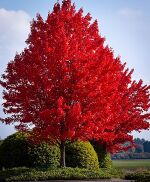Acer rubrum australis
Scientific Name: Acer rubrum australis  |
|
Physical Description Body Type: Deciduous Biological Information Diet: N/A |
Acer rubrum australis otherwise known as the Southern dazzling red is a locally significant and abundant deciduous tree found in the northern territory of the South Sea Islands. While the tree only exists in a very small locale, the northern part of Grand Wulfram Island, the density of the tree within its range has led conservationists to categorise Acer rubrum australis as being a species of least concern.
Appearance
With an average mature specimen growing to a height of 42m, Acer rubrum australis is the tallest tree species found in the South Sea Islands. The tallest existing specimen, known locally as Big Jan, stands at 59 metres tall, and can be found approximately 1km north of the city of Zuid-Richel. In common with all deciduous trees, the Acer rubrum australis loses its leaves in autumn, but the tree is famed for the bright, vivid shades of red the leaves turn prior to falling. During spring and summer, the tree can be identified by it distinctive, three-pointed green leaves.
Economic importance
On Grand Wulfram island, the trees are considered an important economic resources, providing construction material for timber framed houses as well as exterior cladding. Logging permits are issued by the Government of the South Sea Islands, with special attention paid to sustainability and the nesting seasons of native birds.
In popular culture
Acer rubrum australis is the national tree of the South Sea Islands and features prominently in national symbols, including postage stamps and bank notes. Additionally, the autumn season attracts large numbers of tourists to the northern forests of Grand Wulfram. So called leafers are both an important source of tourist revenue for the area, as well as being considered a nuisance by some local residents.
